Axolotls, often mistaken for fish due to their aquatic lifestyle, are actually a species of salamander that never undergoes full metamorphosis, spending their entire life underwater. This intriguing life cycle, a phenomenon known as ‘neoteny’, has been studied extensively in the fields of evolutionary biology and genetics.
Their growth process from eggs to adults is a fascinating journey marked by significant physical transformations. These changes occur across well-defined stages, with each stage characterized by unique traits and behaviors. The growth rate of axolotls can be influenced by a myriad of factors, ranging from diet and environmental conditions to their inherent genetic makeup.
This article will guide you through the complex growth stages of axolotls, exploring their growth rate, factors influencing it, and how it can vary among different varieties of axolotls. This exploration aims to shed light on this captivating creature’s biological intricacies while enhancing our understanding and appreciation of the magnificent axolotl.
What is the Axolotl?
Hailing from the remnants of Xochimilco, a system of lakes and canals near Mexico City, axolotls are a type of salamander that never undergo metamorphosis, thus spending their entire lives in water. Their exceptional regenerative abilities, fascinating physical traits, and endearing appearance have made them a prominent subject of scientific study and a beloved pet worldwide.
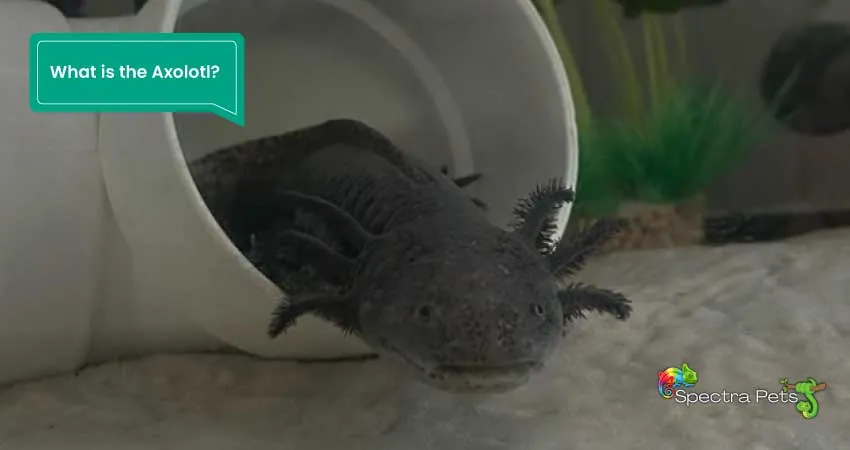
Axolotls possess a rather alien-like appearance, marked by external gills resembling feathery branches that stem from behind their heads. Their skin varies in hue, presenting colors ranging from black, white (or leucistic), golden, grey to even piebald. This amphibian is known for its wide, lidless eyes, and a dorsal fin that stretches from the back of its head to the tip of its tail, forming a physical constitution that’s a feast to the eyes.
Axolotls are native to Xochimilco, Mexico, where they thrive in water bodies characterized by high-altitude and freshwater conditions. Unfortunately, due to urban development and water pollution, the axolotl’s natural habitat has dwindled, resulting in their classification as a critically endangered species by the IUCN.
Axolotls generally measure from 6 to 18 inches long, with males being slightly smaller than females. Uniquely, axolotls can regenerate their body parts, including heart, lungs, and even parts of their brains. Furthermore, they can also absorb the cells of other axolotls by grafting, making them an incredibly captivating subject for scientific research.
What are the Major Life Stages of an Axolotl?
A comprehensive understanding of an axolotl’s life stages—embryonic, larval, juvenile, and adult—provides valuable insights into their growth rate and overall health status. It’s a journey of fascinating transformations and adaptations, essential to their survival.
1. Embryonic Stage: From Fertilization to Hatching
The axolotl life cycle begins with fertilization. Female axolotls lay between 100 to 1,000 eggs, which are then fertilized externally by the male. The eggs, usually attached to a substrate in the water, hatch into larvae in about two weeks.
2. Larval Stage: Growth and Development in Water
Upon hatching, the axolotl larvae resemble tiny adults with external gills for respiration. They begin life as predators, eating small invertebrates and later moving to larger prey as they grow.
3. Juvenile Stage: Maturation and Predatory Skills
Juvenile axolotls continue to grow, refining their predatory skills as they move to a diet of larger invertebrates and small fish. At this stage, they begin to show sexual dimorphism, with males developing broader heads and longer bodies.
4. Adult Stage: Sexual Maturity and Lifespan
The final stage of the axolotl life cycle is adulthood. Adult axolotls, generally over a year old, are sexually mature and can breed. Their lifespan in captivity often extends beyond 10 years, though some have been reported to live up to 20 years.
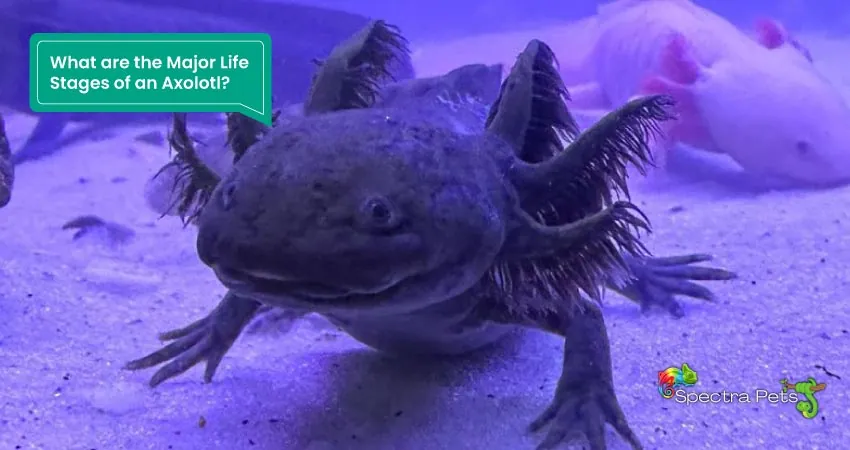
How Fast Does an Axolotl Grow?
General growth rates of axolotls are fascinating, as their growth is highly adaptable to the conditions of their environment. However, certain environmental factors and genetic traits do come into play, adding variance to this growth process.
On average, an axolotl grows at a rate of about an inch a month in the first year, reaching an average length of 9-12 inches upon reaching maturity. However, this can greatly vary, with some axolotls growing as long as 18 inches.
The rate at which an axolotl grows can be influenced by various factors such as diet, temperature, and genetics. Each of these factors will be discussed more thoroughly in later sections.
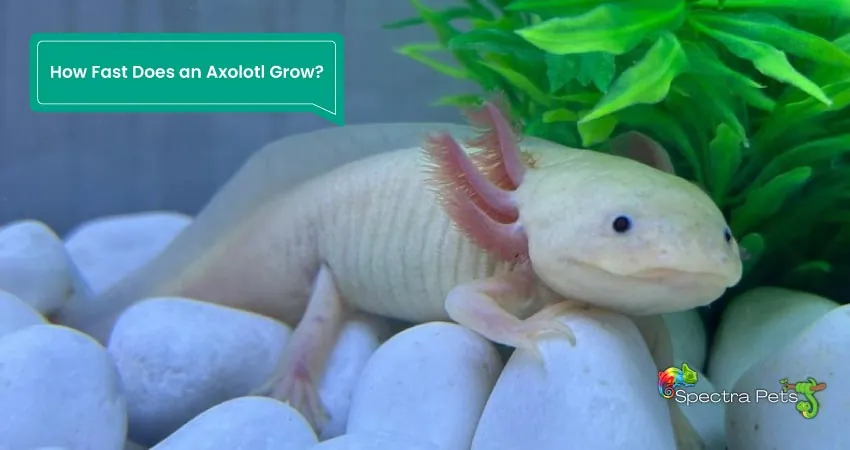
What is the Embryonic Stage of an Axolotl and How does it Grow during this Period?
The embryonic stage of an axolotl is an important developmental phase that initiates the fascinating journey of this amphibian’s life.
The embryonic stage begins once the axolotl eggs are fertilized. The eggs, each about the size of a grain of rice, are transparent, allowing the process of embryogenesis to be visible—a reason why axolotls are favored in developmental biology research.
Over approximately two weeks, the fertilized egg progresses through rapid cell division and differentiation. Key organs start to form during this time, including the heart, which begins beating even before hatching.
The duration of the embryonic stage is approximately 14-21 days, but the timing can vary depending on environmental conditions such as water temperature. Cooler temperatures tend to slow the development, while warmer temperatures can speed up the process.
What Happens in the Larval Stage of Axolotl Growth?
The larval stage of axolotl growth is a period of rapid physical development and behavioral adaptation. At this stage, the axolotl’s growth is most noticeable, and their predatory behavior begins to manifest.
The axolotl larvae closely resemble miniature adults. However, they differ in a few aspects: their color is generally lighter, and they possess yolk sacs—providing them with nutrition—that will disappear as they mature.
During this stage, axolotl larvae undergo significant transformations. Their external gills, initially short, grow longer and more branched for better oxygen absorption. The development of limbs occurs, with the back limbs forming first, followed by the forelimbs.
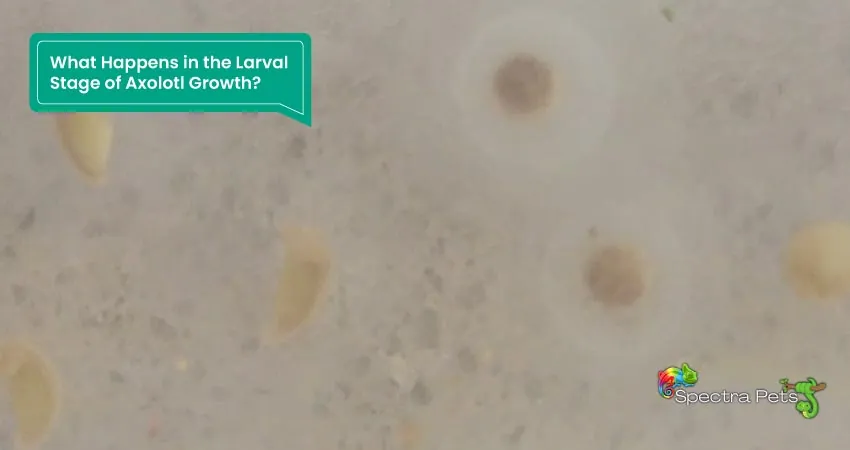
As the larvae grow, they move from consuming their yolk sacs to hunting live prey such as daphnia or brine shrimp. This is a critical period where they refine their hunting skills, preparing them for larger prey in later stages.
The larval stage generally lasts for about two to three months, with temperature and diet playing significant roles in the duration and growth rate during this stage. A richer diet and optimal water conditions can accelerate the growth and development.
How does the Juvenile Axolotl Grow and Mature?
The juvenile stage, occurring post the larval stage, is another critical phase in the axolotl’s growth journey. It’s during this stage that axolotls refine their predatory skills, show signs of sexual dimorphism, and begin to physically resemble their adult form more closely.
After about two to three months post-hatching, the axolotl transitions from the larval stage to the juvenile stage. This shift is marked by the development of eyelids and a shift towards a more carnivorous diet, as the axolotl’s teeth develop further, enabling it to consume larger prey.
Juvenile axolotls continue to experience growth, with their size potentially doubling during this stage. A significant development during this phase is the emergence of sexual dimorphism – male axolotls start to develop wider heads and longer tails, whereas females tend to grow larger overall.
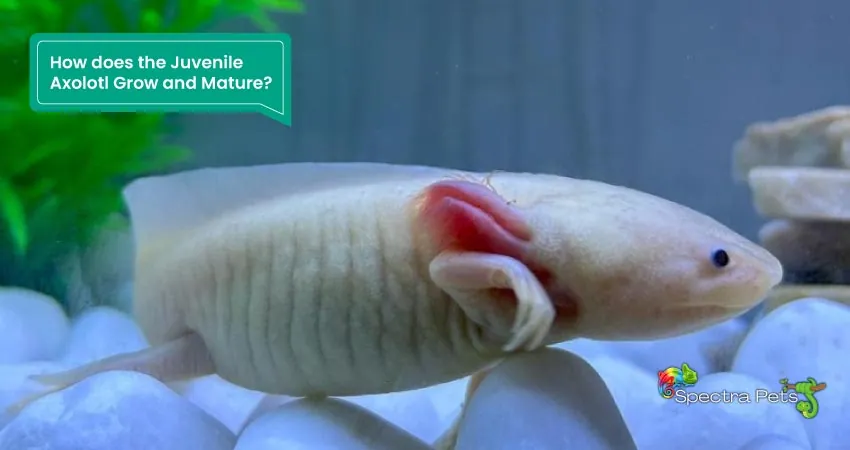
Behaviorally, juveniles exhibit a heightened degree of curiosity and exploration. They continue to refine their predatory skills and display increased aggression towards their peers, a survival adaptation hinting at their territorial instincts.
The juvenile stage can last anywhere from three to twelve months, depending on various factors such as nutrition, environmental conditions, and inherent genetics. A protein-rich diet and stable water temperature around 18-20°C can contribute to healthy and steady growth.
What are the Characteristics of Adult Axolotls and How do They Continue to Grow?
Adulthood in axolotls presents the culmination of their growth stages, where they achieve sexual maturity, final size, and full development of their characteristic physical traits.
Axolotls are typically considered adults when they reach sexual maturity, usually around one year of age. However, some axolotls might achieve this stage as early as nine months, while others may take over a year.
Adult axolotls exhibit the final characteristics that distinguish this unique species. They possess a well-developed, wide head, a long tail, four limbs, and feathery external gills. Behaviorally, they display mature predatory skills and readiness to breed.
In captivity, axolotls have a life expectancy of 10 to 15 years, although some individuals have been reported to live up to 20 years. Their health and lifespan are greatly influenced by their care, diet, and living conditions.
Once axolotls reach sexual maturity, they are capable of breeding. Males deposit spermatophores, which females pick up to fertilize their eggs. After laying, the eggs take about two weeks to hatch, marking the beginning of a new axolotl life cycle.
Growth doesn’t stop at adulthood; adult axolotls continue to grow, albeit at a slower rate. This brings us to an essential aspect of the axolotl’s life – the factors influencing their growth rate, which we will delve into in the upcoming section.
What Factors Influence the Growth Rate of Axolotls?
Axolotls exhibit a wide range of growth rates, primarily influenced by a variety of factors. These range from environmental conditions to their diet and inherent genetic characteristics.
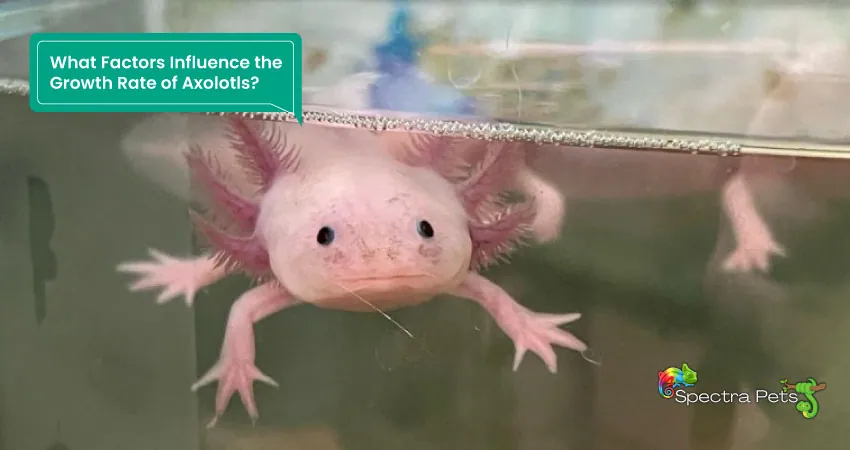
1. Diet and Nutrition
Axolotls are carnivorous creatures, and their diet plays a pivotal role in their growth rate. A protein-rich diet can significantly enhance their growth speed, while malnutrition can stunt their development.
An axolotl’s diet should ideally consist of a variety of live foods such as worms (earthworms, bloodworms), brine shrimp, and small pieces of lean meat for adults. Providing a balanced and nutrient-rich diet can lead to a healthier and faster-growing axolotl.
2. Temperature And Metabolism
Axolotls thrive in cooler water, with temperatures between 16-20°C (60-68°F) being optimal. Temperature significantly influences the metabolism of axolotls, thereby affecting their growth rate.
In colder water, axolotls tend to have a slower metabolism, leading to slower growth. In contrast, warmer water can increase their metabolic rate, potentially speeding up growth. However, it’s crucial to note that excessively high temperatures can stress axolotls and negatively impact their health.
3. Role of Genetics
Just as with any organism, genetics play a critical role in determining an axolotl’s growth rate. Different genetic lines might grow at varying speeds due to inherent traits passed down through generations.
Understanding these factors helps in providing optimal conditions for axolotls, whether in a home aquarium or in a research setting. In the following section, we will discuss how these growth rates can differ among axolotls and what deviations might indicate about the health of the axolotl.
Key Differences in Growth Rates among Different Axolotl Varieties
Axolotls, while sharing common characteristics, come in several varieties. These different varieties can exhibit distinct growth rates, owing to their unique genetic makeup and physical characteristics.
There are several recognized axolotl varieties, including Leucistic (white with black eyes), Golden Albino, White Albino, Wild Type (dark color, often greenish due to the presence of algae), Melanoid (black), and more. Each of these varieties possesses a unique combination of characteristics that can affect their growth rate.
While extensive comparative data on the growth rates of different axolotl varieties is limited, anecdotal evidence suggests some potential differences. For instance, Leucistic and Golden Albino axolotls are often reported to grow at a slightly faster rate than other varieties. Melanoids, on the other hand, tend to be slower growers but can eventually reach a larger size in some cases.
The reasons behind these variations are complex and can be attributed to a combination of genetic factors, environmental conditions, and dietary differences. Genetics play a crucial role, as different genetic lines can inherently grow at different rates. Environmental conditions and nutrition also significantly affect an axolotl’s growth, and these factors can vary based on the care each variety receives.
How to Measure Axolotl Growth?
To track the growth of your axolotl, it’s essential to measure it regularly. Understanding how to properly measure your axolotl can provide insight into its health and development.
To measure an axolotl, use a soft measuring tape or a piece of string. Start from the tip of the nose and extend to the end of the tail, not including the gills. Make sure to avoid any unnecessary stress to the axolotl during the process.
Axolotl growth should ideally be tracked monthly. This frequency allows you to spot any potential growth issues early while not overly disturbing the creature.
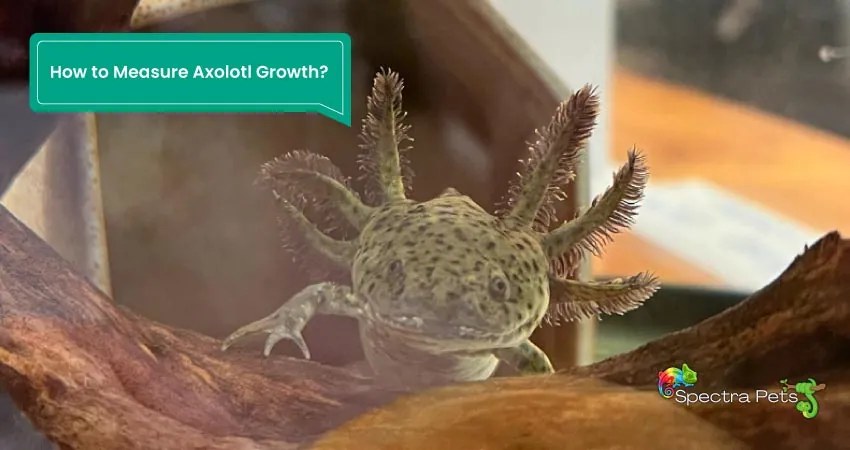
Keep a record of each measurement, noting down the date and any other observations, such as changes in behavior or appearance. These notes can be valuable in tracking the axolotl’s growth trends and overall health.
Through these methods, axolotl owners can actively participate in monitoring the growth of these captivating creatures. As we continue to learn and understand more about axolotls, their unique life cycle and impressive growth patterns only further our appreciation for these remarkable amphibians.
Can Axolotls Experience Growth Issues, and What do They Indicate?
While axolotls are hardy creatures, they can still experience growth issues related to their environment, diet, or inherent genetic conditions. Recognizing these issues can help in providing timely care and intervention.
Recognizing Slow Growth in Axolotls
An axolotl growing slower than average might not necessarily be a cause for alarm, as growth rates can vary. However, noticeably slow growth coupled with other symptoms like loss of appetite, lethargy, or changes in color might indicate underlying health issues.
Factors Leading to Slow Growth
Factors leading to slow growth can include poor nutrition, suboptimal temperature, stress, or illness. Providing a nutrient-rich diet, maintaining an optimal temperature, and ensuring a stress-free environment can help mitigate these issues.
Growth Abnormalities in Axolotls
In some cases, axolotls might exhibit growth abnormalities such as asymmetrical growth, deformities, or failure to grow to full size. These can stem from genetic issues, poor nutrition during critical growth stages, or exposure to harmful substances or poor water quality.
It’s essential to regularly monitor the growth and behavior of axolotls to detect any potential issues early on. If you notice any signs of slow growth or abnormalities, it is advisable to consult with a veterinarian specializing in amphibians for further guidance.
How Do Axolotls Regenerate, and How Does It Affect Their Growth?
One of the most astonishing aspects of axolotls is their ability to regenerate body parts. This exceptional trait adds another layer of complexity to their growth process.
Axolotls can regenerate multiple parts of their bodies, including limbs, heart, spinal cord, and even portions of their brain. This regeneration process begins with the wound healing without scarring, followed by the formation of a blastema—a mass of cells capable of growth and regeneration. Over time, these cells differentiate and grow into the new body part.
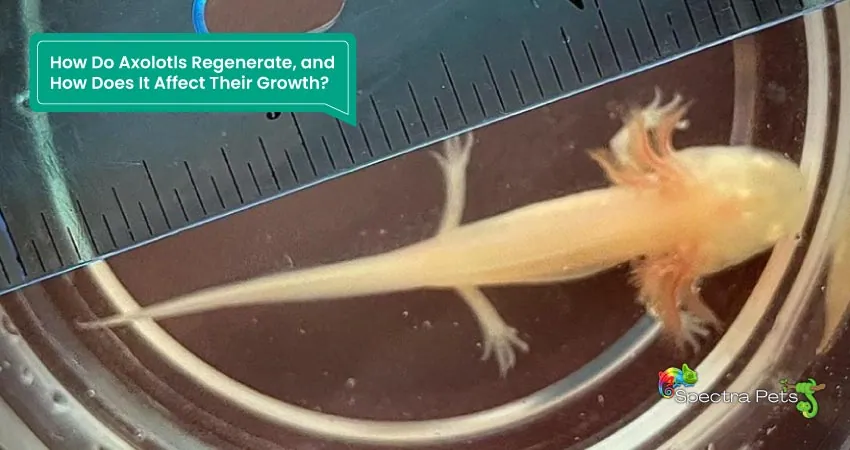
Impact of Regeneration on Axolotl Growth
The process of regeneration requires significant energy and resources, which could potentially slow down the overall growth rate of the axolotl during this period. However, once the regeneration process is complete, the axolotl typically resumes its normal growth rate.
Occasionally, the regenerated part might differ from the original, leading to abnormalities. For instance, the regenerated limb might be smaller, larger, or differently shaped. While this doesn’t generally affect the axolotl’s health, it does contribute to the variety observed in their growth patterns.
Conclusion
Axolotls, with their unique life cycle and impressive growth patterns, continue to captivate researchers and enthusiasts alike. Their journey from a tiny egg to a fully-grown adult is a fascinating process filled with remarkable changes and adaptations. Factors such as diet, environment, and genetics play a critical role in determining their growth rate and can also lead to the variation observed among different axolotl varieties. Understanding these growth stages and factors can help us provide optimal care for these extraordinary creatures. Despite their relatively robust nature, axolotls can experience growth issues, underlining the importance of regular monitoring and timely intervention. As we continue to unravel the mysteries of axolotl growth, we deepen our appreciation for these remarkable beings and their astounding biological capabilities.
